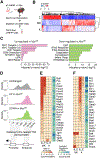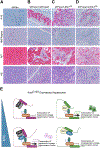MYC determines lineage commitment in KRAS-driven primary liver cancer development
- PMID: 36906109
- PMCID: PMC10330789
- DOI: 10.1016/j.jhep.2023.02.039
MYC determines lineage commitment in KRAS-driven primary liver cancer development
Abstract
Background & aims: Primary liver cancer (PLC) comprises hepatocellular carcinoma (HCC) and intrahepatic cholangiocarcinoma (iCCA), two frequent and lethal tumour types that differ regarding their tumour biology and responses to cancer therapies. Liver cells harbour a high degree of cellular plasticity and can give rise to either HCC or iCCA. However, little is known about the cell-intrinsic mechanisms directing an oncogenically transformed liver cell to either HCC or iCCA. The scope of this study was to identify cell-intrinsic factors determining lineage commitment in PLC.
Methods: Cross-species transcriptomic and epigenetic profiling was applied to murine HCCs and iCCAs and to two human PLC cohorts. Integrative data analysis comprised epigenetic Landscape In Silico deletion Analysis (LISA) of transcriptomic data and Hypergeometric Optimization of Motif EnRichment (HOMER) analysis of chromatin accessibility data. Identified candidate genes were subjected to functional genetic testing in non-germline genetically engineered PLC mouse models (shRNAmir knockdown or overexpression of full-length cDNAs).
Results: Integrative bioinformatic analyses of transcriptomic and epigenetic data pinpointed the Forkhead-family transcription factors FOXA1 and FOXA2 as MYC-dependent determination factors of the HCC lineage. Conversely, the ETS family transcription factor ETS1 was identified as a determinant of the iCCA lineage, which was found to be suppressed by MYC during HCC development. Strikingly, shRNA-mediated suppression of FOXA1 and FOXA2 with concomitant ETS1 expression fully switched HCC to iCCA development in PLC mouse models.
Conclusions: The herein reported data establish MYC as a key determinant of lineage commitment in PLC and provide a molecular explanation why common liver-damaging risk factors such as alcoholic or non-alcoholic steatohepatitis can lead to either HCC or iCCA.
Impact and implications: Liver cancer is a major health problem and comprises hepatocellular carcinoma (HCC) and intrahepatic cholangiocarcinoma (iCCA), two frequent and lethal tumour types that differ regarding their morphology, tumour biology, and responses to cancer therapies. We identified the transcription factor and oncogenic master regulator MYC as a switch between HCC and iCCA development. When MYC levels are high at the time point when a hepatocyte becomes a tumour cell, an HCC is growing out. Conversely, if MYC levels are low at this time point, the result is the outgrowth of an iCCA. Our study provides a molecular explanation why common liver-damaging risk factors such as alcoholic or non-alcoholic steatohepatitis can lead to either HCC or iCCA. Furthermore, our data harbour potential for the development of better PLC therapies.
Keywords: Cancer; Cell of origin; Hepatocellular carcinoma (HCC); Hepatocyte; Intrahepatic cholangiocarcinoma (iCCA); Liver; MYC.
Copyright © 2023 The Authors. Published by Elsevier B.V. All rights reserved.
Conflict of interest statement
J.Z is a founder, shareholders and scientific advisor of Quantro Therapeutics and receives research support and funding from Boehringer Ingelheim. Other authors declare no potential conflicts of interest.
Figures





References
-
- Llovet JM, Kelley RK, Villanueva A, Singal AG, Pikarsky E, Roayaie S, et al. Hepatocellular carcinoma. Nat Rev Dis Primers 2021;7:6. - PubMed
-
- Villanueva A Hepatocellular Carcinoma. N Engl J Med 2019;380:1450–1462. - PubMed
-
- Finn RS, Ryoo BY, Merle P, Kudo M, Bouattour M, Lim HY, et al. Pembrolizumab As Second-Line Therapy in Patients With Advanced Hepatocellular Carcinoma in KEYNOTE-240: A Randomized, Double-Blind, Phase III Trial. J Clin Oncol 2020;38:193–202. - PubMed
Publication types
MeSH terms
Substances
Grants and funding
LinkOut - more resources
Full Text Sources
Medical
Molecular Biology Databases
Miscellaneous

